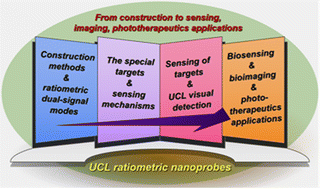Ratiometric upconversion luminescence nanoprobes from construction to sensing, imaging, and phototherapeutics
Abstract
In terms of the combined advantages of upconversion luminescence (UCL) properties and dual-signal ratiometric outputs toward specific targets, the ratiometric UCL nanoprobes exhibit significant applications. This review summarizes and discusses the recent advances in ratiometric UCL nanoprobes, mainly including the construction of nanoprobe systems for sensing, imaging, and phototherapeutics. First, the construction strategies are introduced, involving different types of nanoprobe systems, construction methods, and ratiometric dual-signal modes. Then, the sensing applications are summarized, involving types of targets, sensing mechanisms, sensing targets, and naked-eye visual detection of UCL colors. Afterward, the phototherapeutic applications are discussed, including bio-toxicity, bio-distribution, biosensing, and bioimaging at the level of living cells and small animals, and biomedicine therapy. Particularly, each section is commented on by discussing the state-of-the-art relevant studies on ratiometric UCL nanoprobe systems. Moreover, the current status, challenges, and perspectives in the forthcoming studies are discussed. This review facilitates the exploration of functionally luminescent nanoprobes for excellent sensing, imaging, biomedicine, and multiple applications in significant fields.

- This article is part of the themed collection: Recent Review Articles


 Please wait while we load your content...
Please wait while we load your content...